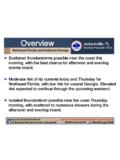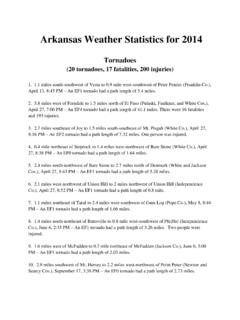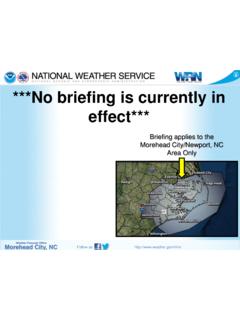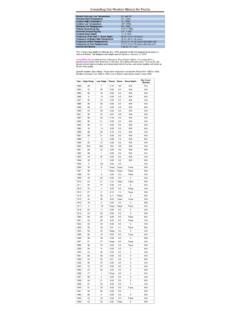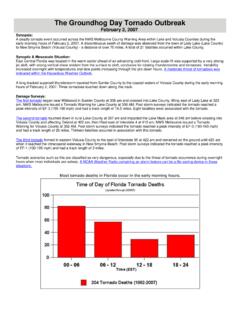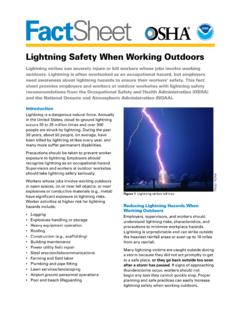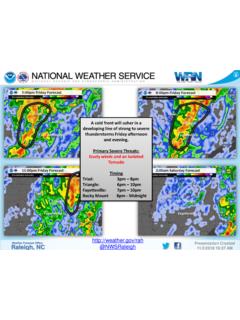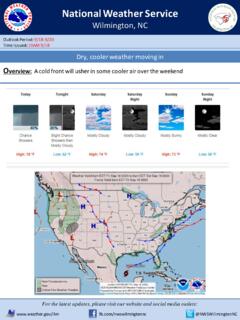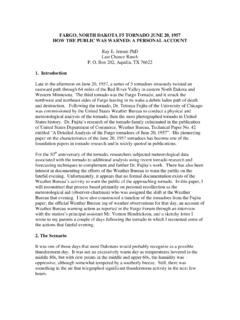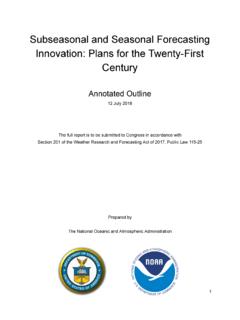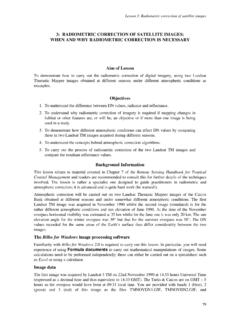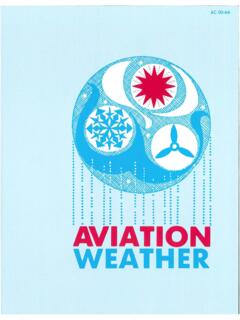Transcription of Career Opportunities in Meteorology - National Weather …
1 What is Meteorology ? Meteorology is the study of Weather , climate, and the forces that cause change in our environment. It uses math and physics to understand the atmosphere, which consist of layers of gases and moisture surrounding the earth. Most Weather takes place in the lowest level of the atmosphere, known as the troposphere. Within Meteorology there are a number of specialty fields which include climatology, severe storms and tornadoes, tropical cyclones, hydrology, and agriculture. Detailed research is applied through Meteorology subsets, including multiple scales (synoptic, meso-, and micro scale), satellite , radar, and cloud physics. What do Meteorologists do? Many people think a meteorologist is the person who explains the forecast on television. However, television meteorologists make up only a small percentage of Career meteorologists.
2 Meteorologists are involved with research, teaching, consulting, and forecasting. They are employed by universities, private companies, and the government. Background To start a meteorological Career , good to excellent high school grades are needed, especially in math, physics, chemistry, computer science, English, and even social studies. Meteorology is a math-based profession that requires an excellent understanding of calculus and physics. If possible, you should graduate from high school prepared to take college-level calculus classes. Computer science is also very important, learning computer programming and keyboard skills will be helpful. Teamwork, the ability to work under pressure, and multi-tasking skills will enhance Career possibilities. Historically, the Meteorology profession has been underrepresented by women and minorities, but that is changing rapidly.
3 If you are a woman and/or minority who has a strong interest in math and sciences, the Weather enterprise may be just the field for you! Basic requirements A 4-year degree ( ) in Meteorology /atmospheric science is the minimum requirement for a meteorologist. Many colleges and universities offer Meteorology degrees. However, some schools offer specific Meteorology degrees, while others offer degrees for broadcast Meteorology or atmospheric science, so choose carefully. Upon entering college, outside of the required Meteorology coursework you can expect to take 4 semesters of calculus, 2 semesters of physics, and a chemistry class in your first two years. Most Meteorology courses will be taken during your junior and senior year. Additionally, graduating with a minor or additional coursework in computer hardware & software, communications, business, agriculture, geography, social sciences, chemistry, physics, or math may prove beneficial depending on the Career path you choose.
4 An excellent grade point average is also helpful for success in landing a well-paying job. While nearly all meteorologists have a Bachelor of Science degree, acquiring a Master s Degree or Doctor of Philosophy (Ph. D.) is becoming more common. These advanced degrees generally increase one s earning potential and allow one to enter a specialty field. Anyone wishing to go into research should be prepared to get a Ph. D. Job Market The Meteorology job market is very competitive, with the supply of meteorologists exceeding demand. Currently, universities and colleges in the graduate 600 to 1000 meteorologists each year. One research study indicated that the number of entry-level Meteorology positions available in the each year is approximately only half the number of newly degreed meteorologists. The number of new, traditional, entry-level positions has not been increasing along with the number of meteorologists entering the workforce, nor is it expected to in the next few years.
5 Trends suggest there will be an increasing oversupply of Meteorology graduates in the coming years, and that some meteorologists will have a difficult time finding a traditional Weather -related job. Flexibility in job location and type of Meteorology -related job will enhance a person s chances of being hired. Growth in non-traditional Weather -related jobs is increasing in the private and public sector. In other words, get your foot in the door and worry about where you are working later in your Career . Most people who get into Meteorology do so for the love of all things Weather and climate, not for the money. Diverse skills and a willingness to seek a variety of Weather and climate related jobs ensure a long, fulfilling Career . Career Opportunities in Meteorology Possible Meteorology Jobs Meteorologists are found in the public sector (military, federal and state government), private sector (media, commercial companies, etc.)
6 , and academia (post graduate research, professorships). Today s employers are looking for more than a traditional meteorological curriculum. Computer skills, ranging from software (programming, GIS) to systems (hardware-software interface) are vital. Speaking and writing skills are equally important, and for some careers, emphasis is shifting to social science in helping to understand the needs for Weather and climate information by decision makers and vulnerable communities. NOAA/NWS: The National Oceanic and Atmospheric Administration s (NOAA) National Weather Service (NWS) is this nation s largest employer of meteorologists. NWS hires only about 50-75 new meteorologists annually, while universities graduate hundreds. NWS currently employs about 4600 people, of which about 3600 are meteorologists. The NWS has 122 field offices, 6 regional offices, several specialty or research centers, and a headquarters near Washington, DC.
7 Field office and specialty forecast center meteorologists work rotating shifts on an equal, 24/7 basis. The primary mission of NWS to save lives and protect property is conducted directly from field offices and specialty centers. Hazardous Weather warnings and related information for persons and structures on land and at sea are most critical. Routine Weather forecasts, local climate reports, hydrology forecasts and data collection follow. NWS field meteorologists work closely with the university community, the media, emergency managers, and other local, state, and federal agencies. Meteorologists on a traditional schedule can be found in regional offices and at National Headquarters, supporting the mission by conducting research to improve hazardous Weather information. This research is used to improve radar technology and techniques, conduct hydrologic studies and renew mapping, manage the agency s performance, and much more, Managers from the local field offices to National Headquarters lead the agency by working with forecasters and researchers to ensure the NWS core mission is met successfully.
8 The federal government also employs meteorologists in a number of specialty agencies as part of NOAA. The NOAA Storm Prediction Center initiates tornado and severe thunderstorm watches. The NOAA National Hurricane Center (NHC) tracks hurricanes. Numerous forecast products are issued by the NOAA Aviation Weather Center to help pilots. Real-time monitoring of the climate and collection of climate data is handled by the Climate Prediction Center. NOAA s Hydrometeorological Prediction Center forecast heavy rain events across the country. In addition, ongoing research occurs at a number of laboratories and National centers, including the NOAA National Severe Storms Laboratory. As of 2010, new NWS meteorologists earn roughly $30-45,000 in their first year, depending on education and prior work experience, and can climb the Career ladder and reach a comfortable position in about 2 to 6 years, depending on their skills and talents.
9 These positions, starting at the General Schedule 11 grade scale, pay $57-69,000 per year to start. Senior forecasters and middle level management earn $80-100,000 per year; it may take an individual at least 10 years to reach this level. Upper-level management earns $95,000-115,000 per year to start; top managers can earn up to $200,000 per year. Other NOAA. NWS is not the only option in the civilian federal sector for meteorologists. Other agencies, including the National Ocean Service, the Office of Atmospheric Research, the National Environmental satellite , Data, and Information Service, and the Office of Program Planning and Integration hire meteorologists to support NOAA s mission to predict and observe oceanic and atmospheric activity and stewardship of the environment. Armed Services: The Air Force and Navy have a need for meteorologists.
10 Job locations can span the globe. Annual pay varies by rank, but a good number of meteorologists in the military earn $50-100,000 per year, or higher. Contact the Air Force or Navy for additional details. Partial or full scholarships are available to those who qualify through the ROTC program for those with an interest in Meteorology . Media: Everyone has probably seen a television (TV) meteorologist. They work in small, medium, and large markets. A growing number of TV stations have at least one meteorologist on station, depending on the size of the station s market, and interest in hiring meteorologists (vs. weathercasters) by the program manager. Each TV meteorologist is an independent contractor that negotiates his/her own contract with station management. Some TV meteorologists also have radio or newspaper contracts that generate additional income.
